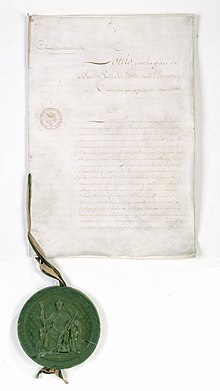Charter constitutionnelle
The Charte constitutionnelle had been the constitution of the restored Kingdom of France since 1814 .
Content
In contrast to the constitutions of the revolutionary era, the charter was not based on the principle of popular sovereignty or the agreement between people and monarch, but was made by Louis XVIII. on the occasion of his accession to the throne on June 4, 1814 on the basis of his monarchical power. The programmatic preamble in the sense of the Restoration came essentially from Jacques Claude Beugnot .
After all, the monarch has been bound by the constitution ever since. Notwithstanding the Apostolic Letter from Pope Pius VII. Post tam diuturnas , it guaranteed central fundamental rights such as equality before the law, individual freedom of opinion, freedom of the press and freedom of religion. Despite all the distancing from the principles of the revolution, the Charte constitutionnelle tied in with the political and administrative innovations of the years 1789 to 1814 in terms of content.
It laid the foundation for a constitutional system with a strong monarchical head. The king was free to appoint and dismiss his ministers, he retained control over the army and navy, freedom of choice over war and peace, he had the right to conclude diplomatic treaties, and in an emergency he had extensive powers of order.
On the other hand, there was a comparatively weak bicameral parliament. This consisted of a chamber of deputies and a chamber of peers . Parliament had the right to approve taxes and laws. The ministers were responsible to Parliament. The pairs as members of a kind of upper house were hereditary seats or were appointed by the king for life. The deputies emerged from elections. However, the right to vote was severely restricted by the census . The active right to vote was a census of 300 francs a year. In total, only about 100,000 people were eligible to vote in France. The right to stand for election was 1000 francs and required the age of 40. Only a minority of 15,000 people were eligible.
Parliament's weakness was also that the king had the right to convene, adjourn and dissolve. The legislative initiative also lay with the crown.
After the brief interlude of the Napoleonic hundred days and a revised constitution of the empire, the Charte constitutionnelle was valid until the July Revolution of 1830 . It was subsequently replaced by a constitution of the same name. This differed from the first version only in a few points. The emergency article was deleted, for example. In addition to the crown, the parliament now also received the right to initiate legislation. Another difference was that it was now based on an agreement between King Louis-Philippe I and the people. Active and passive voting rights were still severely restricted. The constitution of the July Monarchy remained in force until the February Revolution of 1848.
The first charter in particular served as a model for the moderately liberal movement in the first half of the 19th century . In contrast, the determined liberals oriented themselves more towards the Spanish constitution of Cádiz from 1812.
literature
- Heinz-Gerhard Haupt : From the French Revolution to the end of the July Monarchy (1789–1848). In: Ernst Hinrichs (ed.): Little history of France (= Federal Center for Political Education. Series of publications. Vol. 538). Updated and bibliographically supplemented edition. Federal Agency for Civic Education, Bonn 2005, ISBN 3-89331-663-9 , pp. 255-310, here pp. 285 f., 299 f.
- Markus J. Prutsch: The revision of the French constitution in 1830. On the question of the validity of the constitutional system of the “Charte constitutionnelle” of 1814 . In: The State . Journal for state theory and constitutional history, German and European public law. Vol. 47, H. 1, 2008, pp. 85-107, doi : 10.3790 / staa.47.1.85 .
Web links
- Text of the charter from 1814 (on verfassungs.eu)
- Text of the revised charter from 1830 (on verfassungs.eu)
